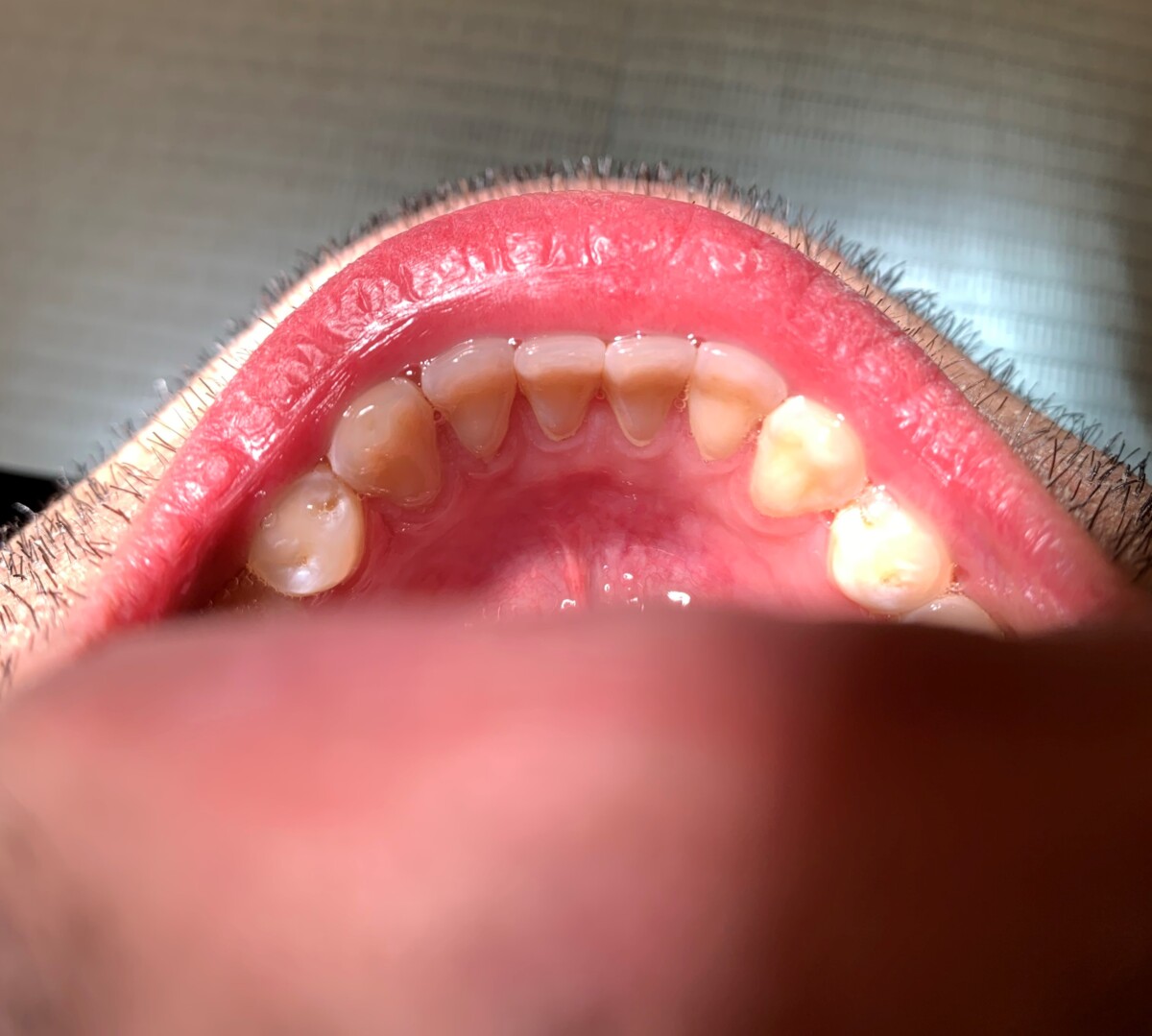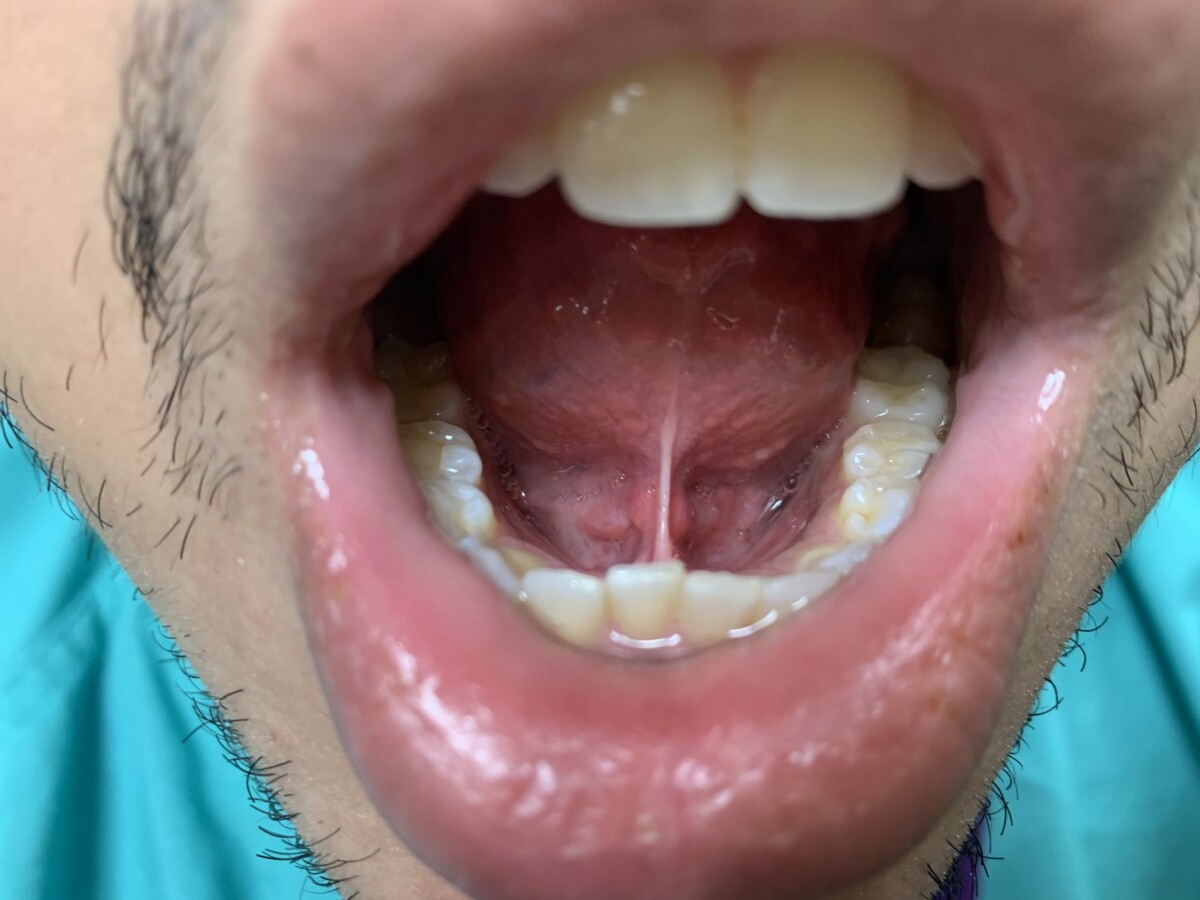Case #1
Patient’s Demographic
- 33 year old
- Male
- Asian
- ASA I
Clinical Assessment
- Patient has received both doses of COVID-19 vaccine on April, 2021.
- Last medical exam was on Jan, 2020; last dental exam and routine cleaning was on July, 2019. Dental radiographs was taken on July, 2019 with 4 HBWs.
- Patient is not a smoker, not a drug user, and does not drink alcohol.
- Patient uses powered toothbrush (Oral B) once a day with back and forth, side to side motion; does not use oral rinse and floss; brush tongue with toothbrush.
- Extraorally patient experiencing dry lips and redness around vermilion border.
- Intraorally patient experiencing slightly short lingual frenulum. Patient also has enlarged bilateral tonsils which leads to partial airway blockage. Due to the his airway blockage during sleep, patient admitted sometimes he breath through his oral cavity, this leads to the anterior teeth calculus buildups due to xerostomia.
- Gingival tissues: generalized pink, slightly bulbous on #22-27 facial with rolled margins; in mandibular lingual posterior areas soft, spongy, with loss of stippling, bulbous papillae and marginal redness was noted.
- Dental assessment: Class of occlusion III with edge-to-edge overjet (0 mm) and overbite (0%). Due to his edge-to-edge situation, attrition noted on #7-10 and #22-27. A Rotated #9 was noted as well. One amalgam site noted on #30 MO surface. Generalized facial fluorosis noted anteriorly and posterioly.
- Periodontal assessment: 4-5mm probing depth noted on mostly posterior teeth. 6-7 mm probing depth noted on #29 and #30. 1 mm gingival recession noted on #22-27 lingually.
- Calculus detection: medium
- Case value: Stage I/ Grade B based on localized RBL ratio with patient’s age.
Treatment Plan
- Exposed patient with 4 VBWs at 7 mA and 70 kVp
- Disclosing solution to evaluate current plaque status
- Educate patient on oral hygiene instructions (OHI) – correct power toothbrushing angulation and proper flossing technique; educate patient on the importance of tongue cleaner and oral rinse
- Provide full mouth deep cleaning/scaling
- Engine polish with medium grit
- 5% fluoride varnish application along with post-operative instructions
Post-operative evaluation
- Treatment plan was accomplished in 2 dental appointments. Gingival tissues less inflamed in comparison to prior treatment and a noticeable reduce amount of calculus.
Case #2
Patient’s Demographic
- 26 year old
- Male
- Hispanic
- ASA II (patient takes Symbicort for seasonal allergy)
Clinical Assessment
- Last medical exam was on October, 2020; last dental exam and routine cleaning was on Feb 23th, 2021; Last dental radiographs exposed on Oct 17,2020 with FMS.
- Patient is not a smoker, not a drug user, and does not drink alcohol.
- Patient uses powered toothbrush (Oral B) twice a day (morning and night); uses oral rinse and floss once a day; brush tongue with toothbrush.
- Extra-oral: right side behind neck, well-demarcated birth mark approximately 5 mm circular shape papule.
- Intra-oral: patient bites on cheeks bilaterally (2 mm macule red lesion on the left buccal mucosa due to biting trauma). Injury lesion noted on the hard palate due to hot beverage trauma prior to the appointment; severe ankylglossia lingual frenulum noted.
- Gingival tissues: during the appointment, patient presents with generalized pale pink, bulbous, slightly inflamed, spongy, on the maxilla and mandible on the anterior areas; generalized pale pink, bulbous, rolled at the gingival margin on the maxilla and mandible posterior areas.
- Dental assessment: Class of occlusion I with overjet 5 mm and overbite 60%. Mild attrition noted on #6-11 and #22-27. #5 D has 2 suspicious caries lesions. Composite noted on #3, #15, and #31; amalgam noted on #14 and #15. #1 and #16 patient stated that both were extracted.
- Periodontal assessment: generalized 4-6 mm probing depth noted on posterior areas with BOP.
- Calculus detection: Heavy
- Case value: Stage II/ Grade B
Treatment plan
- Exposed patient with FMS at 7 mA and 70 kVp
- Disclosing solution for plaque evaluation
- Educate patient on oral hygiene instructions (OHI) – correct power toothbrushing angulation and proper flossing technique; educate patient on the importance of tongue cleaner and oral rinse
- Provide full mouth deep cleaning/scaling
- Engine polish with medium grit
- 5% fluoride varnish application along with post-operative instructions
Post-operative evaluation
- Treatment plan was accomplished in 3 dental appointments. Gingival tissues improved with less inflammation in comparison to prior treatment and a noticeable reduce amount of calculus.





